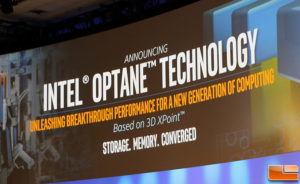This website uses cookies so that we can provide you with the best user experience possible. Cookie information is stored in your browser and performs functions such as recognising you when you return to our website and helping our team to understand which sections of the website you find most interesting and useful.
 After attending Intel’s Developer Forum last week a few things about 3D XPoint from my previous blog need to be updated. This technology will be marketed by Intel under the name “Optane” and available in 2.5” SSDs leveraging the new U.2 NVMe connector and in DDR form-factors, the same dual in-line memory module (DIMM) packaging as DRAM.
After attending Intel’s Developer Forum last week a few things about 3D XPoint from my previous blog need to be updated. This technology will be marketed by Intel under the name “Optane” and available in 2.5” SSDs leveraging the new U.2 NVMe connector and in DDR form-factors, the same dual in-line memory module (DIMM) packaging as DRAM.
Memory First
First of all, it’s clear that 3D XPoint technology is better suited, at least initially, as a memory solution, rather than a storage solution. To be sure, it will be promoted as an alternative to NAND flash, but doesn’t look to be price competitive for some time, based on the current flash prices, a situation that won’t improve as 3D NAND comes on line.
Flash prices are expected to drop significantly in response to an oversupply due partly to 3D NAND’s greater capacity potential. Solid-state device costs are directly tied to production volume, which in the flash industry comes mostly from consumer products. 3D XPoint doesn’t look to be a consumer products technology, at least not initially. All this adds up to 3D XPoint not being a factor in the NAND flash industry, for a few years anyway.
More Appetite for Memory
One of the themes from the Flash Memory Summit that we attended recently was that users are getting addicted to the performance of solid-state storage. This ‘need for speed’ is also driving up the demand for more server memory to support applications such as in-memory computing and high speed gaming, but also to enable greater density in server virtualization and VDI. This is the market that Intel and Micron seem to be going after with this technology.
3D XPoint is less expensive than DRAM and offers a higher storage density, enabling more memory in servers at a lower cost. It’s also persistent, similar to a non-volatile DIMM (NVDIMM), meaning data isn’t vulnerable to a power loss like it is with DRAM.
An Intel-only Solution
3D XPoint products will be available in DDR form-factors. But that doesn’t mean it’s a “plug replacement” for DRAM; there’s more to it. Memory devices operate most effectively with a fixed clock speed, something that non-volatile technologies like NAND flash can’t do. At IDF we learned that while 3D XPoint DIMMs were “electrically and physically compatible” with DDR4, but would only work with Intel’s chipset. This would indicate that some kind of translation was occurring in the processor in order to accommodate the characteristics of 3D XPoint.
The Bottom Line
If you want to take advantage of 3D XPoint technology to increase server memory affordably, you’ll have to buy a server with Intel CPUs, and one that supports NVMe. This may be OK for end users planning their next server upgrade, but probably not welcome news for existing Intel OEMs that will be further locked in to Intel technology. It may also shut out potential CPU competitors, such as ARM and Power processors.
Many products have long lists of features that sound the same but work very differently. It’s important to think outside of the checkbox of similar-sounding features and understand how technologies and products differ.

